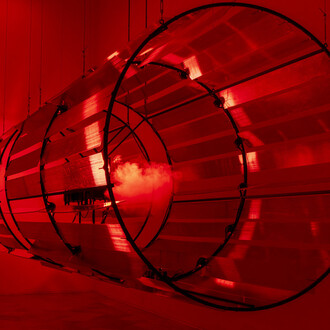The main purpose of this exhibit is to showcase and valorize the photographic holdings of the Andalusian Center for Contemporary Art (CAAC). The consistent quality and commitment of exhibitions at the CAAC are evident, and thanks to acquisitions and donations, we are now able to present this showcase of contemporary photography.
Immersing myself in this vibrant magma that is the CAAC collection has allowed me to engage with unique visual universes, where each piece not only celebrates diversity but explores it as a fundamental principle. For this curatorial work, the museum provided me with an inventory of holdings, a dossier of almost six hundred pages. Throughout the process of focusing and defocusing, on how to open the lens to capture the diversity in the collection, arose the challenge of how to establish different energies that would nourish and mix within the diverse, creating a distinct body for this exhibition.
The quest to create a visual and chromatic vibration from the collection was established as a premise to discover, classify, and approach recurring themes: behavior art and social images of the body; social construction of the landscape; archive practices, memory and politics; photomontages, appropriationism; AFAL; and others. This curatorial journey has been a constant challenge on how to merge such disparate perspectives. Each work in the collection challenges me and has demanded careful reading. I must understand its message and its context. After studying and revisiting them a hundred times, I asked myself a thousand questions. What was intended with each work? How to position the authors? How to engage them all in an expository narrative? Initially, I tried to thread them together and wondered what thread connects Joan Fontcuberta with Daido Moriyama. What is the meeting point between Hermann Nitsch and Miguel Trillo? And the discord? I reflected extensively on how to structure the exhibition, even considering making a very limited selection and disassembling its body to find its essence. However, I realized that if I did not show as much as possible, I would lose the main objective: to showcase the collection.
Although space limitations have prevented the display of all works, those exhibited reflect a carefully curated selection that values diversity as the most distinctive feature of the CAAC collection. These photographic holdings are not merely a collection of images; they are a living testimony to the eclecticism that has guided the CAAC through different curatorial managements.
I have judged worlds, actions, and forms. I have also organized, measured, removed, and added, seeking to find the identity of the showcase. In doing so, I have enjoyed and learned from my fellow photographers. For instance, with Viennese Actionism, I immersed myself in the turmoil of an era, in the search for a political rupture, in the art of the body, in the rawness of the wound. I am contemporary with those ideas; in fact, I believe we are all contemporaries of the images we present.
The identity of the CAAC’s photographic holdings and its most distinctive trait lies in the variety of visual proposals, in its eclecticism. The authors are completely disparate among themselves. Perhaps the origin of this diversity lies in the different exhibition policies of the directors who have passed through the CAAC. Yet, diversity is always vital as a meeting point. It is cultural richness and shared history. Cristina García Rodero, María Cañas, Pierre Gonnord, Agustín Parejo School, among others, merge their breaths with those of Ana Mendieta, Lotty Rosenfeld, Rogelio López Cuenca, Nan Goldin, and other authors of the collection, showing themselves to be complementary, yet all different and alive, bearing witness to fatherhood with their works. Diversity is energy, commitment, and pride. This virtue is distilled in many of the works, for example, in one of the jewels of the collection, the documentary photography of the AFAL collective. Almost all Spanish photographers are indebted to their gazes. Diversity as modern contemporaneity.
The collection is a mirror where we look at the multiple facets of our life and society. We see the metropolis, politics, the social landscape, and the human. There is inclusion and tolerance, radicalism, and feminism. A reflection of this is the work of Valie Export, a pioneer in analyzing gender politics. Commitment is also present in Carrie Mae Weems and her social studies. “We peek surreptitiously from behind the veil of history.” This sentence, taken from a poem by the artist, is included in the catalog edited by the center. This exhibition also highlights the CAAC’s work of documentation, registration, and diffusion through its publications.
Showcasing the quality and variety of the artists present in the CAAC holdings reaffirms the present and a commitment to the future. From here on out, the collection will grow, address its deficiencies, and continue to make its mark in history and the dissemination of contemporary art.
(Text by Alberto García-Alix)
















